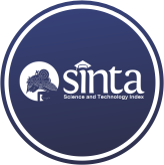Analisis Sentimen Media Sosial Twitter Dengan Algoritma K-Nearest Neighbor Dan Seleksi Fitur Chi-Square (Kasus Omnibus Law Cipta Kerja)
(1) Teknik Informatika, Fakultas Ilmu Komputer, Universitas Singaperbangsa Karawang
(2) Teknik Informatika, Fakultas Ilmu Komputer, Universitas Singaperbangsa Karawang
(3) Teknik Informatika, Fakultas Ilmu Komputer, Universitas Singaperbangsa Karawang
(*) Corresponding Author
Abstract
Full Text:
PDFReferences
Mahardhika, Y.S, and Zuliarso, E. “Analisis Sentimen Terhadap Pemerintahan Joko Widodo Pada Media Sosial Twitter Menggunakan Algoritma Naives Bayes.” Prosiding SINTAK 2018 (2015):409–13, 2018.
Ankit, and Saleena, N. “An Ensemble Classification System for Twitter Sentiment Analysis.” Procedia Computer Science 132(Iccids):937–46. doi: 10.1016/j.procs.2018.05.109, 2018.
Ain, Q.T., Ali,M., Riaz,A., Noureen,A., Kamran,M., Hayat,B., and Rehman, A. “Radiotherapy Is the Gold Standard in Treating Bone Malignancy . Effective in 50-90 % Expectancy Months ).” 8(6), 2017.
Nasution, Muhammad Rangga Aziz, and Mardhiya Hayaty. “Perbandingan Akurasi Dan Waktu Proses Algoritma K-NN Dan SVM Dalam Analisis Sentimen Twitter.” Jurnal Informatika 6(2):226–35. doi: 10.31311/ji.v6i2.5129, 2019.
Luthfiana, Lulu, Julio Christian Young, and Andre Rusli. “Implementasi Algoritma Support Vector Machine Dan Chi Square Untuk Analisis Sentimen User Feedback Aplikasi.” XII(2):125–28, 2020.
Han, Jiawei, Micheline Kamber, and Jian Pei. “Data Mining: Concepts and Techniques.”, 2012.
Kamila, Insanul, Ulya Khairunnisa, and Mustakim. “Perbandingan Algoritma K-Means Dan K-Medoids Untuk Pengelompokan Data Transaksi Bongkar Muat Di Provinsi Riau.” Jurnal Ilmiah Rekayasa Dan Manajemen Sistem Informasi 5(1):119. doi: 10.24014/rmsi.v5i1.7381, 2019.
R. Feldman dan J. Sanger, “The Text Mining Handbook, New York: Cambridge University Press”, 2007.
Rivki, M., and Bachtiar, A.M. “Implementasi Algoritma K-Nearest Neighbor Dalam Pengklasifikasian Follower Twitter Yang Menggunakan Bahasa Indonesia.” Jurnal Sistem Informasi 13(1):31. doi: 10.21609/jsi.v13i1.500, 2017.
Amrullah, Ahmad Zuli, Andi Sofyan Anas, and Muh Adrian Juniarta Hidayat. 2020. “Analisis Sentimen Movie Review Menggunakan Naive Bayes Classifier Dengan Seleksi Fitur Chi Square.” Jurnal 2(1):40–44. doi: 10.30812/bite.v2i1.804, 2020.
Ipmawati, Joang, Kusrini, and Emha Taufiq Luthfi. “Komparasi Teknik Klasifikasi Teks Mining Pada Analisis Sentimen.” Indonesian Journal on Networking and Security 6(1):28–36, 2017.
Deviyanto, A., and Wahyudi, M.D.R. “Penerapan Analisis Sentimen Pada Pengguna Twitter Menggunakan Metode K-Nearest Neighbor.” JISKA (Jurnal Informatika Sunan Kalijaga) 3(1):1. doi: 10.14421/jiska.2018.31-01., 2018.
Ibrahim, N., Bacheramsyah, T.F., Hidayat,B., and Darana, S. “Pengklasifikasian Grade Telur Ayam Negeri Menggunakan Klasifikasi K-Nearest Neighbor Berbasis Android.” ELKOMIKA: Jurnal Teknik Energi Elektrik, Teknik Telekomunikasi, & Teknik Elektronika 6(2):288. doi: 10.26760/elkomika.v6i2.288, 2018
Han, Jiawei, Micheline Kamber, and Jian Pei. “Data Mining: Concepts and Techniques.”, 2012.
Mardi, Y. “Data Mining : Klasifikasi Menggunakan Algoritma C4.5.” Jurnal Edik Informatika 2(2):213–19. 2017.
Gullo, F. “From Patterns in Data to Knowledge Discovery: What Data Mining Can Do.” Physics Procedia 62:18–22. doi: 10.1016/j.phpro.2015.02.005. 2015.
DOI: http://dx.doi.org/10.30645/j-sakti.v5i2.386
Refbacks
- There are currently no refbacks.
J-SAKTI (Jurnal Sains Komputer & Informatika)
Published Papers Indexed/Abstracted By:
Jumlah Kunjungan :











